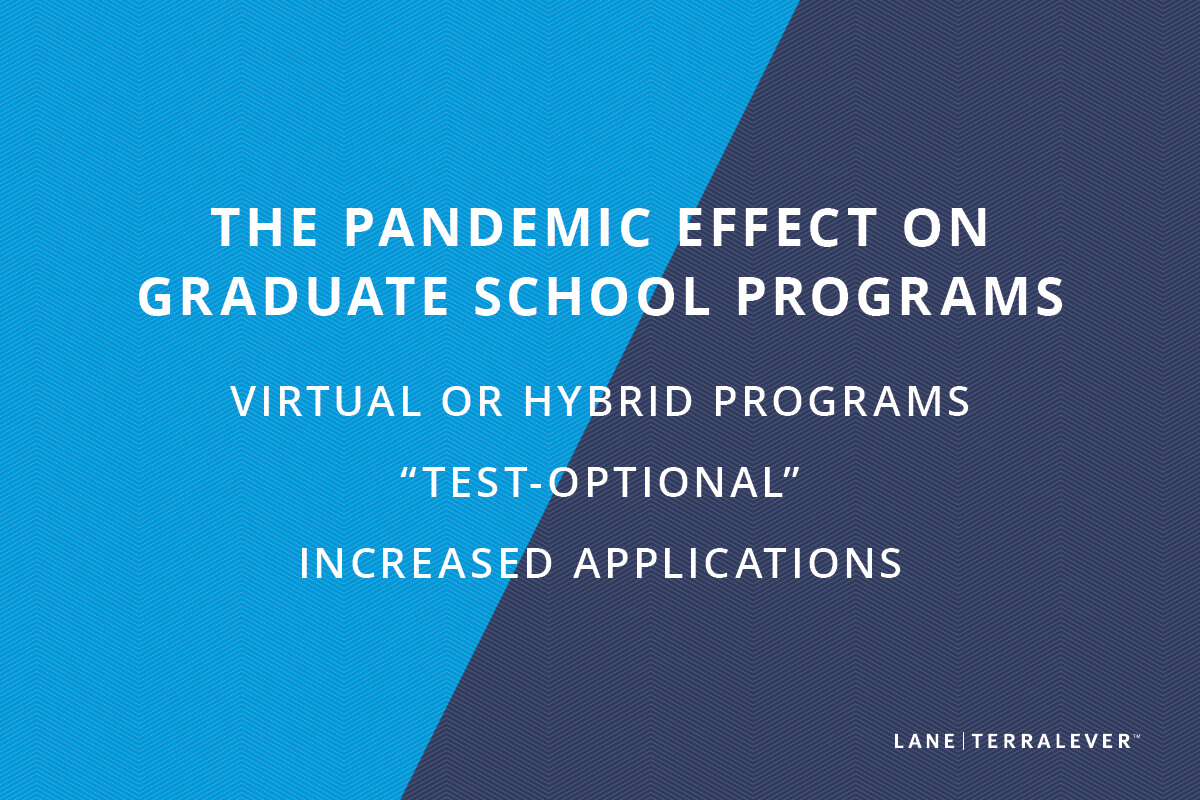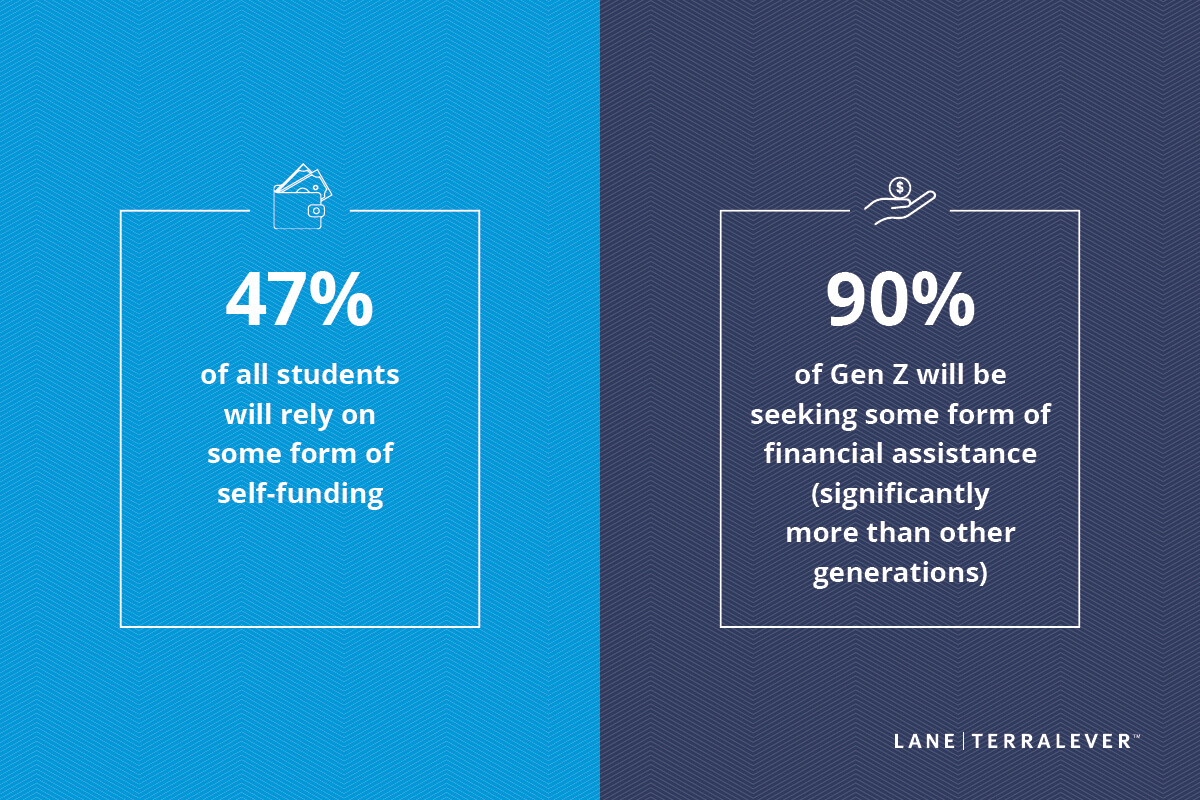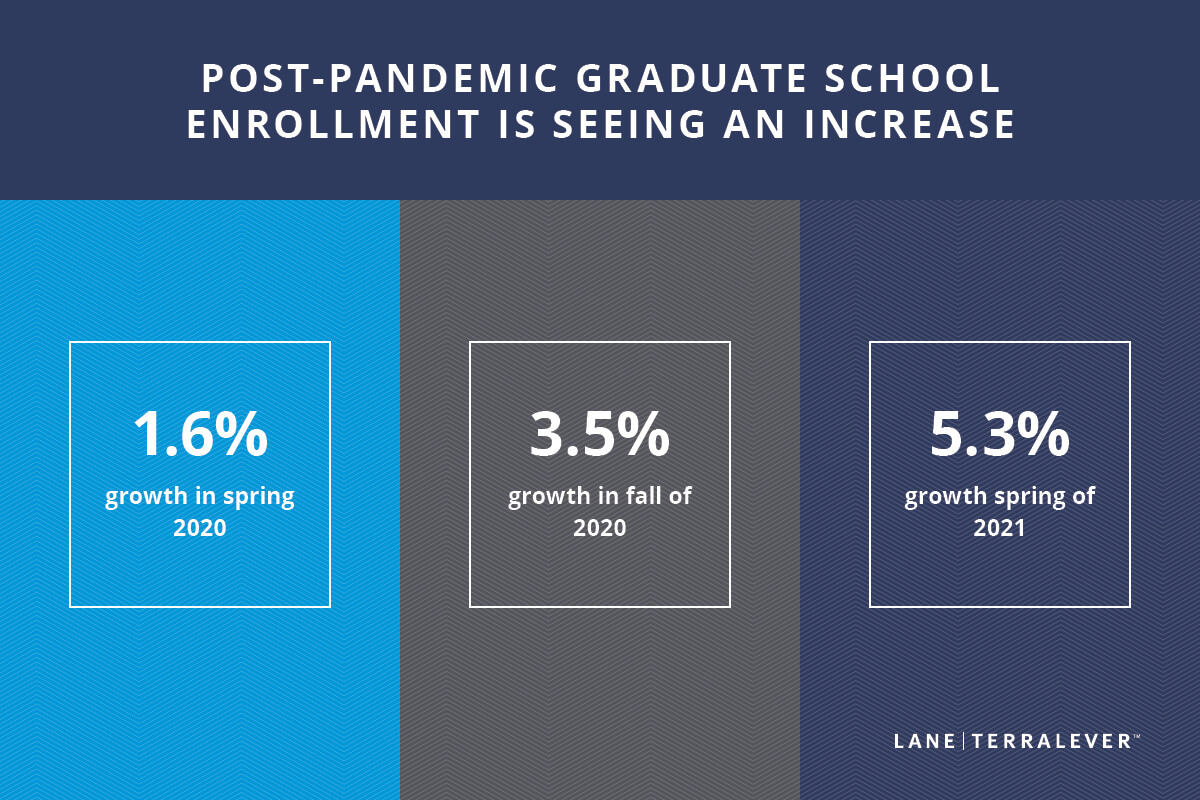How the Pandemic Affected Graduate School Enrollment
The COVID-19 pandemic truly affected the entire world. Lockdowns and mandates changed the way people work, play, and learn. For higher education, there were significant effects on graduate school enrollment.
Here, we will explore the impact of the pandemic, specifically pre-pandemic and post-pandemic changes that have been felt by both prospective and current graduate students, and graduate schools themselves.

Changes in Graduate School Programs
Not only did the pandemic affect enrollment numbers, it also has changed the way graduate schools are offering their programs. The top major shifts include:
A shift to virtual. During the COVID-19 lockdowns, higher education institutions had to pivot fast in order to accommodate students who were now stuck at home, so online offerings became key.
While life has increasingly returned to a new normal, many schools are still offering an array of online or hybrid learning formats for students because a new model of flexibility is now incorporated into the thread of society. This is especially vital for older graduate students who also have a career or a family.
A shift away from testing. For graduate student applications, many colleges and universities actually suspended their GRE requirements for the 2021-2022 admissions cycle. It’s still to be seen if this requirement will make its way back into the fold, but for now, programs are embracing a much more holistic admissions approach. For example, Stanford University went “test-optional” during the pandemic and saw a 50% increase in applications.
A shift to increased applications. Being home for weeks on end was a real moment of introspection for many Americans. It would appear that going back to school was important to people and this societal pause provided the break and inspiration to do so.
- Over half of law schools reported more than a 50% increase in applications.
- 2 out of 3 MBA programs saw an increase in applications in 2020.
- The Association of American Medical Colleges reported an 18% increase nationwide in medical school applications compared to 2019.
A survey of 2,515 prospective students in graduate management education reported that one-third of the participants said they were applying to graduate school to learn skills they lacked and become competitive in their career.
The Pandemic Effects on Graduate School Funding
There are a variety of ways that students today are funding their Graduate School educations, but the pandemic has certainly put a magnifying glass on the way that students choose to fund their continued education.
Affording Graduate School
According to our research, most prospective grad school students will seek a combination of funding sources to help pay for school with 47% saying they will rely on some form of self-funding. 90% of Gen Z will be seeking some form of financial assistance (significantly more than other generations). A huge factor in deciding when and where to go to school, funding is something that had many thinking carefully about where to invest their time, funds and energy during the pandemic and we’ll continue to see this critical thinking moving forward.

In addition to understanding how students will pay for their schooling, higher education institutions are also running up against money challenges brought on by the pandemic. Institutions like Rutgers University has had to tell many PHD students that the funding for their graduate school research may not exist anymore. “Graduate students whose research was delayed by COVID-19 have been told there is no more money to extend their funding packages.
Using federal emergency funds, the university offered one round of one-year funding extensions earlier in the pandemic to students who had already advanced to Ph.D. candidacy. But because the pandemic wasn’t over in a year, some who received that extension require additional time now to finish their dissertations due to factors beyond their control, such as shuttered archives and restrictions on international travel.” (Inside Higher Ed, 2022) Leaving universities to figure out how to keep these students engaged and encourage them to finish their degrees.
When you consider the barrier to entry for continued education, it is easy to see the impact that the pandemic had on funding. The silver lining for higher education institutions however is that the demand for graduate programs remains high and across the generations students are eager to return to learning.
Pre-Pandemic vs. Post-Pandemic Graduate School Enrollment
Pre-pandemic graduate school enrollment
In the fall of 2019, the National Center for Education Statistics estimated there were 1.7 million full-time post-baccalaureate students and 1.3 million part-time post-baccalaureate students enrolled in U.S. post-secondary schools.
At the time, student populations were predominantly female, for the first time in 40+ years (National Institution for Enrollment Statistics).
Since 1976, higher education institutions have seen a 441% increase in Hispanic and Latino students, who now make up almost 20% of students.
Post-pandemic graduate school enrollment
Now that the pandemic is becoming less disruptive to our lives, it has been fascinating to see what enrollment decisions are still being made by prospective graduate students.  It would appear that the pandemic did not slow master’s program applications. In fact, enrollment increased. This market continues on a growth trajectory that was starting before the pandemic hit.
It would appear that the pandemic did not slow master’s program applications. In fact, enrollment increased. This market continues on a growth trajectory that was starting before the pandemic hit.
- 1.6% growth in spring 2020
- 3.5% of growth in fall of 2020
- 5.3% of growth spring of 2021
If this trend continues, graduate school enrollment will continue to rise and the percentage of the workforce with advanced degrees will go up.
Looking Ahead With LaneTerralever
While the effects of the pandemic on students and graduate student enrollment were felt in many ways, it would appear the trend of student enrollment will continue to increase. At LaneTerralever, we focus on uncovering student insights, developing seamless digital student experiences, and implementing lead generation strategies for higher ed institutions. Our work drives an increased understanding of today’s students and helps improve the quality and quantity of inbound prospective students.
LaneTerralever is a full-service marketing agency and strategic partner for higher education institutions looking to meet target students where they want to be met. We do our research when it comes to customer journey mapping, content marketing, UX design, website development, and are proud to have partnered with some of the leaders in higher education including the American College of Education, Pima Medical Institute, Northern Arizona University, Northcentral University, University of the People, Arizona State University, and Southern California University of Health Sciences.
As a veteran higher education marketing agency, our niche experience can help your higher ed organization become more successful. Reach out to see how we can help your institution connect today.



